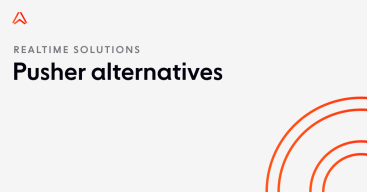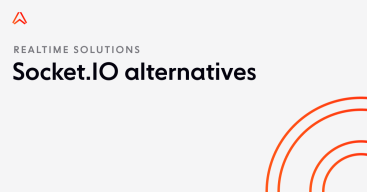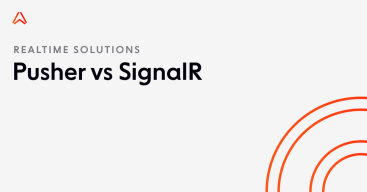- Topics
- /
- Protocols
- &Realtime technologies
- /
- Pusher vs. Socket.IO: which one is best for you?
Pusher vs. Socket.IO: which one is best for you?
This blog post compares Pusher and Socket.IO, two event-driven technologies developers can use for realtime use cases like live chat, broadcasting high-frequency updates (e.g., live sports scores), or realtime location tracking. We’ll cover the following:
What is Pusher?
Acquired by MessageBird in 2020, Pusher is a PaaS designed to add realtime functionality to web and mobile applications. Pusher provides realtime APIs, managed messaging infrastructure, and capabilities like:
Pub/sub messaging (Pusher Channels)
Push notifications (Pusher Beams)
Presence
Authentication, authorization, and encryption
Webhooks

Pusher advantages and disadvantages
Pusher pros
Pusher primarily uses WebSockets for realtime communication, but its JavaScript library can fall back to HTTP streaming and polling in environments where WebSockets aren’t supported (for example, some corporate networks block WebSocket connections).
Client SDKs for every major development platform and programming language, giving you the flexibility of integrating Pusher in your preferred language.
Due to its pub/sub APIs, Pusher supports several messaging patterns: one-to-one, one-to-many (fan-out), and many-to-many.
Pusher cons
Rather weak messaging QoS - message delivery is not guaranteed; for example, if a message is published whilst a client is briefly disconnected (such as going through a tunnel or changing networks), then the message published over Pusher will never arrive to that client.
Compared to some alternative realtime solutions, Pusher offers a limited feature set. For example, it doesn’t support message persistence/history or message delta compression. Additionally, Pusher provides no integrations with services such as event streaming platforms (e.g., Kafka), queuing systems, and serverless platforms (e.g., AWS Lambda, Azure Functions, etc.).
Pusher requires you to choose a single datacenter for an app to reside in. All realtime traffic must therefore be routed through that single datacenter, regardless of a user’s location. This has negative implications on performance (increased latency), reliability, and availability (single point of congestion and failure).
What is Socket.IO?
Socket.IO is an open-source realtime library that enables low-latency, bi-directional communication between web clients and servers. Built on top of the WebSocket protocol, Socket.IO provides additional capabilities compared to raw WebSockets:
Fallback to HTTP long polling for environments where WebSockets aren’t supported (e.g., older browsers and some corporate networks with proxy servers).
Disconnection detection, packet buffering, and automatic reconnections.
Multiplexing (namespaces).
Broadcasting to all clients, or a subset of clients via rooms.
Acknowledgments (via callbacks).

Socket.IO advantages and disadvantages
Socket.IO pros
Making use of namespaces enables you to minimize the number of TCP connections used, and save socket ports on the server, while broadcasting allows you to efficiently distribute data in scenarios where you need to fan out the same message to multiple users.
Socket.IO is easy to get started with; it provides a simple API for both the client side and the server side, making it straightforward to implement realtime functionality into your application.
Integrations with various solutions for horizontal scaling: Redis, MongoDB, Postgres, AMQP / RabbitMQ, so you can choose the one that best suits your needs. Note that you must use one of these when you scale beyond a single Socket.IO server, to pass events between nodes, and ensure that events are properly routed to all clients.
Socket.IO cons
Socket.IO does not guarantee exactly-once messaging semantics. By default, Socket.IO provides an at-most-once delivery guarantee. This means there’s a chance some messages might never get delivered to recipients, especially when poor network conditions and disconnections are involved. If you’re unhappy with the default semantics, you can configure Socket.IO to provide an at-least-once messaging guarantee. However, this brings additional engineering complexity - you have to use acknowledgments, timeouts, assign a unique ID to each event, persist events in a database, and resend events upon reconnections.
Socket.IO offers a limited set of capabilities. Unlike other similar solutions, Socket.IO doesn’t provide features like message history, push notifications, webhooks, or serverless functions. There are only a few client and server implementations (Socket.IO is primarily a JavaScript/Node.js solution), there’s no native support for end-to-end encryption, and no Socket.IO mechanism to generate and renew tokens for authentication.
Socket.IO is designed to work in a single region, rather than a multi-region architecture. This can lead to issues such as increased latency (if your users are in different regions), and even system downtime - what happens if the datacenter where you have your Socket.IO servers goes through an outage?
Comparing Pusher and Socket.IO
We’ll now compare the features and capabilities of Pusher and Socket.IO, outline their differences between, before looking at their similarities.
Pusher vs Socket.IO: comparing features and capabilities
The following table compares Pusher and Socket.IO features and capabilities:
Feature/Capability | Pusher | Socket.IO |
|---|---|---|
Pricing | Pusher prices its two products - Channels and Beams – separately and in tiers. The nature of realtime messaging and streaming data over the public internet means WebSocket connections, required channels, and messages often fluctuate. Plus it’s never easy to estimate how much you’ll need upfront anyway. With Pusher’s pricing model, if you exceed any one attribute of a tier you’ll likely be forced into another more expensive tier. | N/A |
Infrastructure | Hosted / managed for you. | You have to self host / manage it yourself. |
Scalability | Unclear to what extent Pusher can scale. | Unclear to what extent you can scale Socket.IO, but it’s a difficult challenge. |
Latency | Unknown. | Unknown. |
Is there a single point of failure? | Pusher apps are located in a single datacenter rather than distributed across multiple datacenters. If that datacenter goes offline then all apps hosted there are affected. | When you scale beyond one single Socket.IO / WebSocket server, you need to use a tool such as Redis to keep your servers in sync, and ensure that updates are delivered to all relevant clients. However, like all services, you have to expect maintenance windows and some unexpected downtime. When your Redis server (or whatever similar solution you plan to use) is down, your system will also be severely affected. |
Uptime SLA | 99.95% (this amounts to 4h 22m 58s downtime per year). | N/A |
Single-region or multi-region? | Pusher requires you to choose a single datacenter for an app to reside in. All realtime traffic must therefore be routed through a single datacenter, regardless of a user’s location. | Socket.IO is designed to work in a single region. |
Guaranteed message ordering | No | Yes (according to the documentation) |
Guaranteed message delivery (exactly-once) | No | No |
Reconnections with continuity | Provides automatic reconnections, but some messages may never get delivered upon reconnection. | Provides automatic reconnections, but some messages may never get delivered upon reconnection. |
Native push notifications | Pusher provides push notifications through its “Beams” product. | No |
Transport protocols | WebSockets HTTP (fallback) | WebSockets HTTP long polling |
Webhooks | Yes | No |
Integrations | No integrations with third-party services, serverless platforms (e.g. Azure Functions, AWS Lambda) or event streaming platforms (like Kafka or AWS Kinesis), which are often used in realtime architectures. | Only provides a few integrations with tools like Redis, MongoDB, and Postgres. You need to use one of them if you plan to scale to more than one Socket.IO server. |
Serverless functions | No | No |
Message history | No | No |
Pub/sub messaging / broadcast | Pusher provides pub/sub messaging over WebSockets via its “Channels” product. | Socket.IO also allows the server to flexibly broadcast events to clients. You can broadcast to all connected clients, or use the rooms feature to broadcast events to a subset of clients (who have joined the room). |
Message and worker queues | No | No |
Presence | Yes | No |
Security | Security features include authentication and authorization and end-to-end encryption. Pusher is not compliant with standards such as SOC 2 or HIPAA. | Limited native security capabilities (e.g. CORS support). Doesn’t provide more complex features like a mechanism to generate and renew tokens, and end-to-end encryption. |
SDKs | Pusher has client and server SDKs for a considerable range of programming languages and platforms (Java, Android, iOS, JavaScript, Unity, React Native, Python, etc). | Initially, Socket.IO provided a Node.js server and a JavaScript client implementation. More recently, several other server and client SDKs have appeared, targeting languages like Python, Go, and Java (most are community-made and might have a limited feature set). |
What are the key differences between Pusher and Socket.IO?
The first difference of note is that Socket.IO is an open-source technology; its source code is freely available for developers to use. In contrast, Pusher is a commercial (paid) solution. Another key difference is that you have to host and manage Socket.IO yourself (or find someone to do it for you). In comparison, Pusher is a managed, cloud-based offering.
Pusher offers more capabilities compared to Socket.IO. For example, it provides push notifications, webhooks, and presence, which are missing from Socket.IO’s feature set. Pusher also has more client and server SDKs, for a considerable range of programming languages and platforms (Java, Android, iOS, JavaScript, Unity, React Native, Python, etc). Meanwhile, Socket.IO offers one official Socket.IO server implementation (Node.js), and four official client implementations (JavaScript, Java, C++, Swift). Note that there are also a few community-maintained server and client implementations in other languages, such as Python and Golang.
The last difference we’re going to mention is security. Socket.IO provides limited native security capabilities, with no support for end-to-end encryption, and no out-of-the-box mechanism to generate and renew tokens for authentication. In comparison, Pusher has better native security capabilities, such as end-to-end encryption and baked-in authentication.
What are the similarities between Pusher and Socket.IO?
The most obvious similarity is that Pusher and Socket.IO are technologies you can use to power real time functionality in web and mobile apps. They both use the WebSocket protocol as the main underlying transport for sending and receiving data, while offering additional capabilities on top of raw WebSockets, such as automatic fallback to HTTP. See how Pusher and Socket.IO compare to WebSockets:
Another similarity is that Pusher and Socket.IO both offer some flexibility in terms of messaging patterns. To be more exact, SignalR and Socket.IO can be used for 1:1 messaging, but also for 1:many communication. This is made possible by Pusher Channels (pub/sub channels), respectively Socket.IO’s broadcast and rooms features.
The final similarity we’ll bring up in this section: Pusher and Socket.IO are designed to work in a single region, rather than in a multi-region architecture. A single-region design can lead to issues such as:
Increased latency. If perhaps you’re building a game or financial services platform, and latency matters to you, then you have a problem if your visitors are not near your servers. If, for example, you have two users playing a realtime game in Australia, yet your Socket.IO / Pusher servers are located in Europe, every message published will need to go halfway around the world and back.
System downtime. What happens if the region where you have your Socket.IO / Pusher servers is unavailable? Your system would experience downtime, and could become unavailable to your user base (unless you have a backup deployment, which adds engineering complexity and costs).
What kind of realtime features can you build with Pusher and Socket.IO?
Pusher and Socket.IO both address largely the same use cases. You can use them to build realtime apps and features such as:
Realtime charts and activity feeds.
1:1 and group chat.
Multiplayer collaboration features (e.g. cursor tracking, showing who is present, typing indicators).
Multiplayer games.
Broadcasting high-frequency updates (e.g., live score updates).
Pusher and Socket.IO alternatives
Whilst Socket.IO is open-source, and its source code is freely available for any developer to use, building dependable realtime features for end users is a complicated affair.
Although Pusher removes the need to manage realtime infrastructure yourself, it comes with its own limitations. For example, it requires you to choose a single datacenter for an app to reside in, which has negative implications on performance, reliability, and availability.
This means that there are cases where Socket.IO or Pusher won’t be the best choice. In these instances we recommend exploring alternative solutions:
About Ably: An alternative to Socket.IO and Pusher
Ably is a realtime experience infrastructure provider. Our realtime APIs and SDKs help developers power multiplayer collaboration, chat, data synchronization, data broadcast, notifications, and realtime location tracking at internet scale, without having to worry about managing and scaling messy realtime infrastructure.
Find out more about Ably and how we can help with your realtime use case:
Discover the guarantees we provide, including <65 ms round trip latency for 99th percentile, guaranteed message ordering and delivery, global fault tolerance, and a 99.999% uptime SLA.
Learn about our elastically-scalable, globally-distributed edge network capable of streaming billions of messages to millions of concurrently-connected devices.
See what kind of realtime experiences you can build with Ably and check out our chat apps reference guide.
Explore customer stories to see how organizations like HubSpot, Mentimeter, and Genius Sports benefit from trusting Aby with their realtime needs.
Try Ably for free to see how we compare to Socket.IO and Pusher
Recommended Articles

The 5 best Pusher alternatives to consider in 2024
Read about 5 Pusher alternatives for developing functionality like live chat, realtime location tracking, activity feeds, and realtime charts and graphs.

Socket.IO alternatives: Top 5 competitors to consider in 2024
Discover Socket.IO alternatives for engineering realtime features and apps like live chat, polls and quizzes, and multiplayer collaboration.

Pusher vs. SignalR: feature comparison, use cases, pros and cons
Learn how Pusher and SignalR are different, compare their features, understand their pros and cons, and discover alternative solutions you can use to build realtime functionality.
